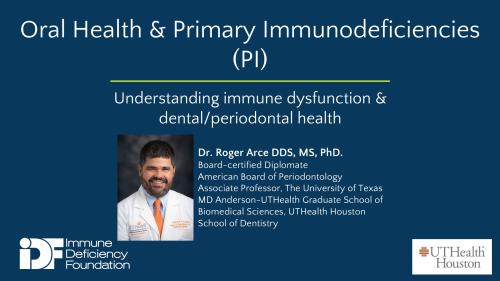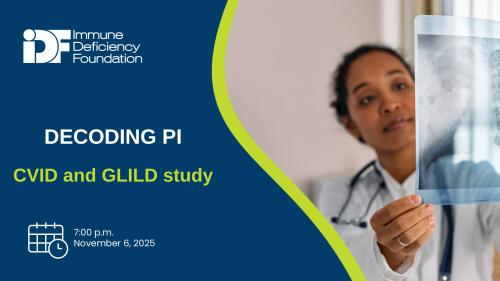
-
Understanding primary immunodeficiency (PI)

Understanding PI
The more you understand about primary immunodeficiency (PI), the better you can live with the disease or support others in your life with PI. Learn more about PI, including the various diagnoses and treatment options.
-
Living with PI
-
Addressing mental health
-
Explaining your diagnosis
- General care
- Get support
- For parents and guardians
-
Managing workplace issues
- Navigating insurance
-
Traveling safely

Living with PI
Living with primary immunodeficiency (PI) can be challenging, but you’re not alone—many people with PI lead full and active lives. With the right support and resources, you can, too.
-
Addressing mental health
-
Get involved

Get involved
Be a hero for those with PI. Change lives by promoting primary immunodeficiency (PI) awareness and taking action in your community through advocacy, donating, volunteering, or fundraising.
-
Advancing research and clinical care
-
Research Grant Program
-
Consulting immunologist
-
Diagnosing PI
-
Getting prior authorization
-
Clinician education
-
Survey research
-
Participating in clinical trials

Advancing research and clinical care
Whether you’re a clinician, researcher, or an individual with primary immunodeficiency (PI), IDF has resources to help you advance the field. Get details on surveys, grants, and clinical trials.
-
Research Grant Program
Primary immunodeficiencies (PI) and allergic reactions, including food allergies, overlap, particularly when certain genes are affected by PI. The topic of how PI and food allergy intersect—and knowing the difference between an allergic reaction to food versus a food intolerance—will be the focus of a presentation by allergist/immunologist Dr. Karen Tuano at the Immune Deficiency Foundation (IDF) 2024 PI Conference June 20-22 in Chicago.
Allergies occur when a person’s immune system overreacts to a substance that is harmless to most people. The occurrence of allergies in someone with PI seems counterintuitive since their body doesn’t generally mount an immune response. However, immune dysregulation that often accompanies PI is one main reason for the reaction.
“I think of the immune system as a spectrum. So, yin and yang. We have to be in balance all the time. If it’s less, it’s an immune deficiency, and if it’s a little bit too much, it’s an allergy and more exaggerated, and that will be autoimmunity and dysregulation. So, it’s quite the same pathway,” said Tuano.

Tuano said only a few of her patients have PI and food allergies, but certain PIs have more risk in general for both food and skin allergies. In a review article summarizing data collected by the United States Immune Deficiency Network (USIDNET), a consortium founded by IDF to advance knowledge of PI, Tuano and other researchers discovered that out of 2,923 patients in the USIDNET registry, 2,263 representing 14 PI diagnoses, reported food allergies, skin allergies, or both.
The review article found that selective IgA deficiency is associated with asthma, allergic rhinitis, and skin and food allergies. Eighty to 100% of patients with Wiskott-Aldrich syndrome (WAS) also present with skin problems and experience food reactivity. Other PIs associated with food allergies included CD40 ligand deficiency (a type of hyper IgM syndrome), hyper IgE syndrome, hypogammaglobulinemia, and common variable immune deficiency (CVID). Skin and food allergies developing later in life could indicate a PI, and if they occur with recurrent infections, they should prompt an immunologic evaluation, concluded the review.
The International Patient Organisation for Primary Immunodeficiency (IPOPI) points out that because some food allergies are prompted by IgE, an antibody that causes allergies, they are most common in people diagnosed with PIs that cause high levels of IgE, such as DOCK8 deficiency (a type of hyper IgE syndrome), IPEX syndrome, and Comel-Netherton syndrome.
Tuano said the food allergies experienced by those with PI don’t differ from those of the general population. Triggers include dairy, wheat, egg, peanut, tree nuts, sesame, fish, and shellfish. In food allergies, the allergic reaction is a skin manifestation like hives or swelling in 90% of cases. Sometimes allergic reactions to food are severe, causing difficulty breathing, gastrointestinal problems, and a drop in blood pressure, symptoms indicative of anaphylaxis and requiring emergency care. Reactions can occur hours after eating the trigger food.
The majority of food allergies present in childhood when a person is first introduced to certain foods. Still, a person can develop allergies to certain foods, like seafood, later in life. Diagnostic evaluation of food allergies involves a blood test or a skin prick to measure IgE levels.
Unfortunately, there’s no cure for food allergy except to avoid the food, said Tuano.
Tuano said patients sometimes confuse food sensitivities with allergies. She said a true food allergy is mediated by allergy antibodies, whereas food intolerance is more commonly associated with gluten and lactose and causes gut issues and bloating.
“When most pediatric parents come in, they’re concerned about lactose intolerance or gluten intolerance. And I keep explaining that this is a little bit different because the diagnostic test that we do is quite different. There’s a massive amount of information on the web, and not all of it is true,” said Tuano.
2026 PI Conference
Join us June 25-27, 2026, in San Antonio, Texas, for a transformative experience where stories connect, voices unite, and journeys inspire. No matter where you are in your primary immunodeficiency journey, access expert-led education, meaningful connections, and cutting-edge insights from world-renowned immunologists.
Register nowTopics
Related resources

Primary immunodeficiency & oral health: Why PI causes gum disease, ulcers, and infections

Cancer risk in primary immunodeficiency (PI): Lymphoma, screening, and treatment explained

Decoding PI: CVID and GLILD with Dr. Michael Jordan
Sign up for updates from IDF
Receive news and helpful resources to your cell phone or inbox. You can change or cancel your subscription at any time.





The Immune Deficiency Foundation improves the diagnosis, treatment, and quality of life for every person affected by primary immunodeficiency.
We foster a community that is connected, engaged, and empowered through advocacy, education, and research.
Combined Charity Campaign | CFC# 66309

